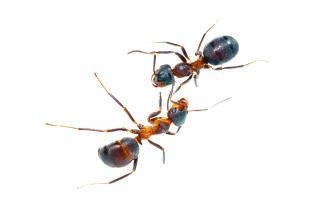Posted: April 5, 2015
Warmer temperatures are often the first sign of spring’s arrival. Shortly afterwards a common six-legged pest also may let you know spring has arrived by making an appearance inside your building.

Ants are social insects with a queen, worker ants, and a nest. After inactivity over the winter, worker ants emerge from the underground nest in search of food. The workers fan out in all directions and can become nuisance pests if the food is found inside your building. When a good food source is found, the ant leaves a chemical trail behind so the other workers can find the food source too. Soon many ants will be heading inside!
Begin addressing an ant problem with proper identification. Carpenter ants are large black ants that can be destructive to buildings. The many species of small household nuisance ants, such as pavement ants, tend to invade kitchen sinks, cabinets and other places with a variety of food sources, preferably sweets. After identification, use the steps of integrated pest management (IPM) to manage a nuisance ant problem before it gets out of hand.
Prevention
Eliminate ants' access to food, water and shelter:
- Use caulking to seal off cracks and crevices around windows, doors and pipes; repair screens.
- Repair water leaks and drips.
- Clean up spills and crumbs.
- Keep food in sealed containers.
- Don't leave food (or pet food) out overnight.
- Keep sinks and drains clean.
Control
- Report the pest problem to the facility's director and/or the pest management professional.
- Follow the ant trails to see how they are getting inside and what foods they are going after.
- Seal their entryway.
- Remove the foods that are attracting them.
- Squish or vacuum up visible ants (be sure to seal and discard the vacuum bag).
- Use vinegar and water or soapy water to wipe up the chemical trails ants leave behind.
- If the prevention and control measures listed above do not solve the problem, talk with your director and/or pest management professional about using a safer, more effective pesticide, such as enclosed, tamper-resistant baits. Be sure they are kept out of the reach of children!
For more information about ants and using IPM to control them both inside and outside, check out the PA IPM Program's fact sheet "Got Ants? Eliminate Ants with IPM."
For more information on preventing pests and keeping your home, school, or child care healthy and safe, visit the website of the Pennsylvania Integrated Pest Management Program. Like us on Facebook. Twitter users can follow us at handle @PAIPM.

